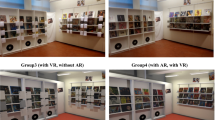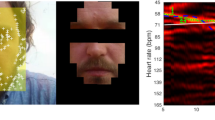Abstract
User behavior is significantly influenced by the surrounding environment. Especially complex and dynamically changing environments (like mobile environment) are represented by a wide variety of extraneous variables, which influence the user behavior in an unpredictable and mostly uncontrolled way. For researchers, it is challenging to measure and analyze the user behavior in such environments. We introduce a complex tool—the IVE tool—which provides a unique way of context visualization and synchronization of measured data of various kinds. Thanks to this tool it is possible to efficiently evaluate data acquired during complex usability tests in a mobile environment. The functionality of this tool is demonstrated on the use case “Navigation of visually impaired users in the building with support of a navigation system called NaviTerier.” During the experiment, we focused on collection and analysis of data that may show user stress and which may influence his/her ability to navigate. We analyzed objective data like Galvanic Skin Response parameter (GSR), Heart Rate Variability parameters (HRV) and audio video recordings and also subjective data like the user’s subjective stress feeling and observation of the user’s behavior.












Similar content being viewed by others
Notes
References
Sandi C, Pinelo-Nava MT (2007) Stress and memory: behavioral effects and neurobiological mechanisms. Neural Plast 2007:78970. doi:10.1155/2007/78970
Salahuddin L, Desok K (2011) Detection of acute stress by heart rate variability using a prototype mobile ECG sensor. http://vega.icu.ac.kr/~kimdesok/IEEE-CS_IEEE-251.pdf. Accessed on 12 Feb 2011
Maly I, Mikovec Z, Vystrcil J (2010) Interactive analytical tool for usability analysis of mobile indoor navigation application. In: Proceedings of the 3rd international conference on human system interaction (HSI 2010), pp 259–266, doi: 10.1109/HSI.2010.5514559
Card SK, Mackinlay JD, Shneiderman B (eds) (1999) Readings in information visualization: using vision to think. Morgan Kaufmann Publishers Inc., San Francisco, pp 686. http://dl.acm.org/citation.cfm?id=300679 or http://www.amazon.com/Readings-Information-Visualization-Interactive-Technologies/dp/1558605339
Kubios HRV (2011) University of Eastern Finland, http://kubios.uku.fi/, Biosignal Analysis and Medical Imaging Group. Accessed 10 April 2010
Kjeldskov J, Skov MB, Als BS et al (2004) Is it worth the hassle? Exploring the added value of evaluating the usability of context-aware mobile systems in the field. In: Proceedings of the MobileHCI conference 2004, pp 61–73. doi:10.1007/978-3-540-28637-0_6
Visifire (2011) http://www.visifire.com/. Accessed 1 Feb 2011
Noldus (2011) Human behavior research. http://www.noldus.com/human-behavior-research. Accessed 26 Jan 2011
Kitchin R, Jacobson RD (1997) Techniques to collect and analyze the cognitive map knowledge of persons with visual impairment or blindness: Issues of validity. J Vis Impair Blind 91:360–376
Bayevsky RM, Ivanova GG, Chireykin LV, Gavrilushkin AP, Dovgalevsky PYa, Kukushkin UA, Mironova TF, Priluzkiy DA, Semenov UN, Fedorov VF, Fleishmann AN, Medvedev MM (2002) HRV Analysis under the usage of different electrocardiography systems (methodical recommendations). These methodical recommendations are prepared according to the order of the Committee of Clinic Diagnostic Apparatus and the Committee of New Medical Techniques of Ministry of Health of Russia (protocol 4 from the 11th of April, 2002), Moskva http://www.vestart.ru/atts/1267/24baevsky.pdf. Accessed 1 Feb 2011
Benoit A, Bonnaud L (2009) Multimodal focus attention and stress detection and feedback in an augmented driver simulator. Pers Ubiquitous Comput 13(1):33–41. doi:10.1007/s00779-007-0173-0
Gray JA (1987) The psychology of fear and stress. Cambridge University Press, Cambridge
Foo P, Warren WH, Duchon A, Tarr MJ (2005) Do humans integrate routes into a cognitive map? map versus landmark-based navigation of novel shortcuts. J Exper Psych Learn Memory Cognition 31:195–215
Bassett JR, Marshall PM, Spillane R (1987) The physiological measurement of acute stress (public speaking) in bank employees. Int J Psychophysiol 5(4):265–273. doi:10.1016/0167-8760(87)90058-4
Yamanaka K, Kawakami M (2011) Convenient evaluation of mental stress with pupil diameter. http://www.ciop.pl/33712 Accessed 1 Feb 2011
Ohsuga M, Shimono F, Genno H (2001) Assessment of physical work stress using autonomic indices. Int J Psychophysiol 40:211–220. doi:10.1016/S0167-8760(00)00189-6
Berntson GG, Bigger JT, Eckberg DL et al (1997) Heart rate variability: origins, methods, and interpretive caveats. Psychophysiology 34(6):623–648. doi:10.1111/j.1469-8986.1997.tb02140.x
Hána K, Smrčka P, Kašpar J, Fiala R, Mužík J et al (2009) The system for monitoring of the human psychophysiological state utility model No. 19422, Czech Industrial Property Office
Gillner S, Mallot HA (1998) Navigation and acquisition of spatial knowledge in a virtual maze. J Cogn Neurosci 10:445–463. doi:10.1162/089892998562861
Tellevik JM (1992) Influence of spatial exploration patterns on cognitive mapping by blindfolded sighted persons. J Vis Impair Blind 86:221–224
Ochaíta E, Huertas JA (1993) Spatial representation by persons who are blind: a study of the effects of learning and development. J Vis Impair Blind 87:37–41
Acknowledgments
This research has been partially supported by the MSMT under the research program MSM 6840770014. This research has also been partially supported by the MSMT under the research program LC-06008 (Center for Computer Graphics). We would like to thank P. Smrcka and R. Kliment from the Joint Department of Biomedical Engineering CTU and Charles University in Prague, Studnickova 7/2028 Praha 2 for consultation and lending of the ECG for measuring HW and SW. We would like to thank the BioDat research group, Gerstner Laboratory, Department of Cybernetics, Faculty of Electrical Engineering, Czech Technical University in Prague for lending of the GSR measuring device.
Author information
Authors and Affiliations
Corresponding author
Rights and permissions
About this article
Cite this article
Maly, I., Mikovec, Z., Vystrcil, J. et al. An evaluation tool for research of user behavior in a realistic mobile environment. Pers Ubiquit Comput 17, 3–14 (2013). https://doi.org/10.1007/s00779-011-0475-0
Received:
Accepted:
Published:
Issue Date:
DOI: https://doi.org/10.1007/s00779-011-0475-0




